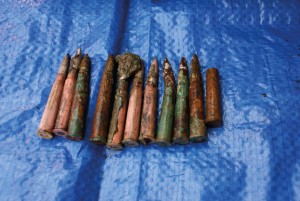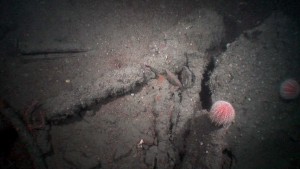‘Ireland spent $1 million preventing research into Lusitania’
Published in 20th-century / Contemporary History, Features, Issue 6 (November/December 2015), Volume 23SO RAN THE HEADLINE OF AN ARTICLE BY THE OWNER OF THE WRECK, GREGG BEMIS, IN THE IRISH TIMES AT THE TIME OF THE CENTENARY OF THE SHIP’S SINKING. MORE DESERVES TO BE KNOWN ABOUT THIS REMARKABLE PIECE OF PUBLIC EXPENDITURE.
By William Kingston
It has long been speculated that the Lusitania was illicitly importing munitions from the United States. The German submarine fired only a single torpedo, which could not possibly have caused one of the biggest ships in the world to sink in a mere eighteen minutes. Survivors testified to hearing a second, much larger explosion, and it has always been suspected that this was because of the ship’s secret cargo of explosives.
The 90m depth of the wreck kept it safe from investigation until after the Second World War. Once it became technically feasible, however, it attracted interest, beginning in the 1950s with the British Admiralty, which has always denied that there were explosives aboard but which conducted a series of ‘depth-charge practices’ in an attempt to obscure evidence. Then in the late 1960s ex-US navy diver John Light set up in Kinsale to build a mobile saturation diving situation, a first of its kind. In 1982 a Houston company called Oceaneering Inc. brought up a number of artefacts, some of which were auctioned off.
Gregg Bemis came to own the wreck through the financial collapse of Light’s ambitious project. Bemis believed that modern techniques would enable the question of the second explosion to be finally resolved, but first he sought and received confirmation of his ownership from courts in the US, the UK and Ireland. In 1987 national territorial limits were extended from three nautical miles to twelve, and this brought the wreck just inside Irish territorial waters. With this extended jurisdiction, and on the basis of unsubstantiated speculation that paintings belonging to Sir Hugh Lane (who had been lost in the sinking) could be on board, the Department of Arts, Heritage and the Gaeltacht (DAHG) issued the wreck with an Underwater Heritage Order, which effectively refused Bemis a licence to explore his own property, leaving him no option but to seek judicial review.

Opposite: A selection of the c. 4m rounds of ammunition salvaged from the Lusitania in 2008. (Eoin McGarry)
The High Court subsequently ruled that ‘this refusal was unjust, irrational and unreasonable and was ultra vires the power vested in the minister’. Costs were awarded against the government; instead of accepting this, the DAHG appealed the judgement to the Supreme Court, whose decision was that ‘the minister had misunderstood the scope of the licensing scheme under section 3(5) of the 1987 Act and had failed to apply that provision in a rational manner’. Once again the government had to pay Bemis’s costs as well as its own.
After this, the DAHG gave Bemis a licence, which he used with support from the National Geographic Society in Washington to mount a major expedition in 2011. At a showing in Cork of the resulting film, the then minister, Jimmy Deenihan, expressed regret for past ‘differences’ and promised full cooperation in future. He also talked about a Lusitania centre in the Cork area, which might rival that of the Titanic in Belfast, as the result of Bemis’s research and recovery of artefacts.
This did not happen. The terms of the licence issued to Bemis in July 2013 were prohibitive. One of these was for Bemis to indemnify the government, something for which, to date, no insurance company has offered cover. Secondly, the Monuments Service had to approve the entire project methodology despite their total inexperience of work at the depth involved or for the task required. While the minister offered to provide a member of his underwater archaeology unit, not only was this offer not fulfilled but also these archaeologists do not possess the technology for it. Additionally, Bemis was charged with production of results from third parties over whom he had no control.
Prior to the centenary commemoration, with Bemis’s approval, Eoin McGarry, one of Ireland’s most experienced divers, then applied to recover artefacts, including the ship’s whistle and an engine-room telegraph. In this case, too, imposs-ible conditions were laid down. One was that before McGarry could start he must get Bemis and the National Museum to reach agreement about the disposition of artefacts previously recovered. Although Bemis had funded all the research that produced these items belonging to him, the National Museum will allow him only a single porthole, with no compensation for the rest. Finally, in a formal arbitration procedure, the DAHG refused to modify these conditions in any manner that would make investment in the proposed research possible.

One of several ‘hedgehog’ mines (many unexploded) left scattered around the Lusitania wreck in the wake of British Navy ‘depth-charge practices’ in the 1950s. (Eoin McGarry)
The DAHG claims that ‘the rules that apply to Mr Bemis are the same as for everybody else’, but there are two reasons why this is wrong. First, these conditions were developed to deal with small-scale exploration in limited depths. They are quite unsuited to a project in very deep water, requiring personnel and equipment that has to be contracted for several years ahead and costing over a million euros. Second, nobody can claim ownership of whatever might be discovered by exploration under the DAHG’s rules, such as the Armada cannon brought up recently. But, as confirmed by the courts, Bemis actually owns the Lusitania hull, so what he wants to explore is his own property. The Irish Constitution is exceptionally supportive of private property rights, and the courts have made it clear that any interference with them requires very strong justification on grounds of the ‘public good’. There is no conceivable ‘public good’ case against the research that Bemis is prepared to finance—the opposite, in fact, since the public could only benefit from its success.
What has been driving the Irish state in what looks like a totally negative direction? The wreck is deteriorating by the day through environmental abuse, rogue divers can access it and steal from it, fishermen’s nets consistently damage it, and the only person with the means and the motive to explore it properly is being denied the opportunity. What could be a quite exceptional contribution to Irish underwater scientific research has been thwarted by the very body that should be encouraging it. Worse, a combination of politicians and civil servants has run up a huge bill in legal fees for the Irish taxpayer in order to prevent Lusitania from being explored until she is no longer worth exploring.
An element in this must be the well-known difficulty that civil servants have in admitting error because of the potential damage to their career paths. The High Court found that the DAHG was wrong to refuse permission originally and the Supreme Court found that it was wrong to appeal this decision. Minister Deenihan told Bemis ‘that he had to do what his staff advised’. Continuing obstruction could then reflect determination on their part not to allow anything that could suggest that faulty advice had been given to the minister. We seem to be dealing here with a classic case of bureaucratic abuse of power.
William Kingston is in the Business School of Trinity College, Dublin.
Further reading
P. O’Sullivan, The sinking of the Lusitania: unravelling the mysteries (Dublin, 2014).
M. Peake, K. Walsh-Johnson & S. Jones, The Lusitania story (Barnsley, 2015).
















